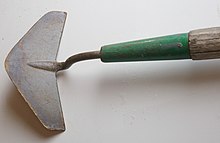Schuffel
The shuffle is a garden tool for pulling weeds in beds and on paths. The term Stieger is also used in northern Germany. Many tool manufacturers and dealers also use their own trade names and word creations for tools based on this functional principle. Since there are different leaf shapes, sizes and types of attachment to the stem, there is a large variety of products. The common feature of these tools is that they are special forms of the hoe , which are not used with the typical chopping movements, but rather by applying light pressure while moving horizontally to and fro on the ground.
advantages
By pulling and pushing hoes, the top soil layer is loosened, which, due to the interruption of the capillaries in the soil, greatly reduces the evaporation of soil moisture and maintains the cooking state of the soil. Furthermore, weeds below the vegetation point are cut off from the roots or their position in the soil below the roots is loosened so that they either wither or can be easily picked up or raked.
Due to the way the tool is guided, there is no need to lift the tool for chopping, so, given a suitable soil condition, work can be carried out at a high speed and with less effort.
Only small amounts of earth are moved, as only the layer of earth is cut. This saves the power for earth movements and the earth remains in its original distribution.
Constructive features and variations
The thin hoe blade and handle form an angle of about 150 degrees. The flat angle is needed so that a large proportion of the force applied to the handle can be converted into the horizontal movements. Long handles are required due to the flat handle position. The handle is optimally long when it reaches the operator's chest when the hoe is set up at an angle.
An advantageous sheet size results from weighing several factors. For weeding in row crops, the leaf size is limited by the row spacing. While a large sheet size favors a high area coverage, the expenditure of force increases at the same time and handling in confined spaces is restricted. The leaf shapes used also vary greatly. The blade shape and the blade attachment depend on whether, on the one hand, easy handling is to be achieved in confined spaces (free guidance of the implement, cutting off weeds in any direction) or, on the other hand, the exact opposite, guidance of the blade only in the two main directions, such as it is favorable when working in long rows of plants. The blade of the shuffle can, as shown in the picture, be angled, but also straight. Diamond-shaped, round, semicircular, sickle-shaped or other shapes, e.g. B. with serrated cutting edge are also common. Attachment directly to the handle is also common, as is to a bracket that has the socket for the handle.
Limitations of Use and Alternative Tools
Root weeds such as dandelion and dock, which form new plants from root remains in the ground, can only be weakened with the shuffle, but not permanently removed, as only the upper parts of the plant are cut off.
While light and sandy soils and gravel can be efficiently weeded with the shuffle, handling the shuffle beneath the surface and, in particular, dipping it into the ground is increasingly difficult as the heaviness and moisture of the soil increase. Hacking movements that would facilitate penetration are difficult to carry out. Here the missing angle of attack of the hoe blade becomes noticeable. Since the blade position of the shuffle is identical for both a pulling movement and a pushing movement, the blade can only be adjusted to a more favorable angle during the movement by raising and lowering the handle, which can result in ergonomically unfavorable postures. A hoe or a hoe whose angle of the blade is optimized for the respective direction of movement can therefore be used more efficiently in difficult soil conditions.
A pendulum hoe works on the same principle, but the blade is attached to a movable joint so that the blade assumes different angles of attack for moving the hoe forwards (pushing) and for moving backwards (pulling). This makes it easier to penetrate the soil as it requires less downward pressure on the stem. The need to raise and lower the handle is reduced. The pendulum movement thus offers some ergonomic advantages, but this hoe is more complex to manufacture due to the moving parts. The pendulum hoe is particularly widespread in Switzerland.
When weeding between row crops under foil or directly on plants, wire hoes can be used as an alternative, as the risk of damage to the foil or the plants is reduced.
Instead of a rigid blade, ironing hooks use flexible metal strips as blades, which cut through suitable floors with particularly little resistance. If the blade is badly worn, only the metal strip needs to be replaced. From steel strapping, a material that is used to fasten goods on pallets and which is generated as waste, you can make efficient hoops yourself.
But also with pendulum hoe, wire hoe and iron hoe, the soil conditions must permit use.
Further meaning
The shuffle is also an important hand tool in agricultural root crop cultivation , if herbicides are not to be used for weed control , as it can also be used between the plants in a row.
The Schuffel is more common in the English-speaking world.
Individual evidence
- ↑ a b Bodo Frahm, BGJ Agrarwirtschaft, 4th edition 1991, Verlag Eugen Ulmer, Stuttgart, page 447 f.
- ↑ Dr. Eric Brennan: New Hoe Design to help Control Weeds in Vegetables, and along Plastic Mulch in Strawberries. January 25, 2016, Retrieved May 30, 2020 (American English).
Web links
- Declaration Wiktionary (English)
- Explanation in the English dictionary (English)
